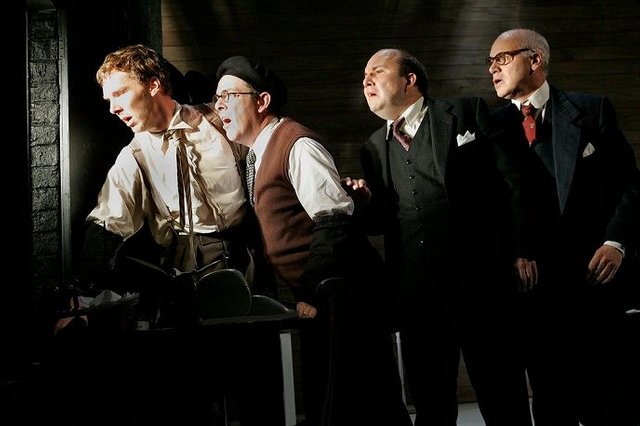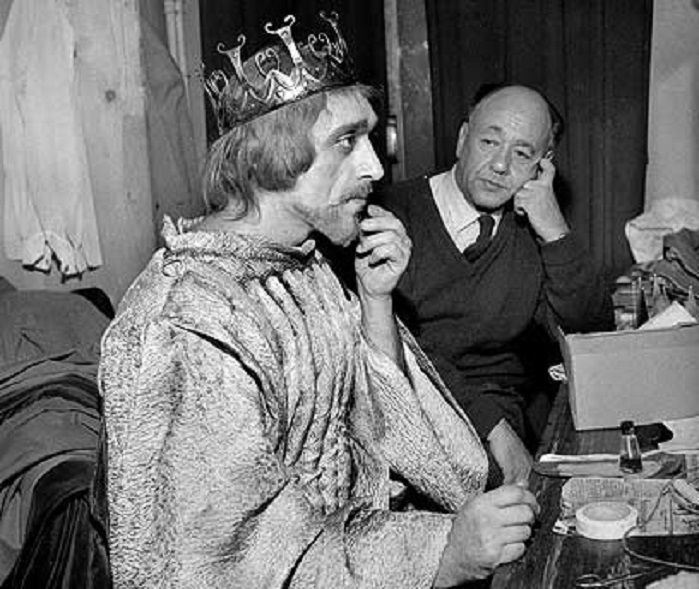The creativity of Eugene Ionesco /part two/
While the language in the semantics plan is disturbed, it remains unchanged in the syntax plan: the characters of Ionesco make the unrelated words in perfectly structured phrases. Human inertia and resignation are the main target to which Ionesco directed his relentless criticism in his play "The Chairs" (1952). The most famous of his plays recreates the drama of two figurines in a frozen world, condemned to repeat the same gestures and phrases, a theater that do not make senseless memories. But the old man still dreams of leaving his message to mankind - a message that will save his likenesses and turn him into a hero. The most prominent representatives of humanity are expected to come together on the same island. Only the speeches that the old man and the old woman make to them will give life to these visitors. Meanwhile, the chairs begin to accumulate, fill the space, push the elders away from their room and force them to escape through the window. They are thrown by him and this is the last leap in their lives. Even the Emperor's appearance personally can not change the development of things. And the orator who has to say the message instead of the suicidal old man turns out to be deaf and dumb. The world from Ionesco 's point of view seems devoid of hope for salvation. Whether it fills the world with words, things or other multitudes of beings, man stays alone.
Under the real or imaginary influence of his fantasies, man ultimately turns out to be driven out of the world by the very things: in the play "The New Tenant" the furniture expels the man; in 1954, one corpse is constantly growing and banishing everyone from home. "Victims of debt" (1953) the glasses displaced people. Since he feels the need to deepen his investigations into the human fate, Ionesco goes on a new path, and in 1957 he becomes an irreducibly classic writer.With the first performance of his play Improvisation in Alma, in 1956, Ionesco was involved in the struggle between supporters of the absurdity theater and the French defenders of the Brecht Theater. To pass from the critique of society and the bourgeois language to the protection of positive values close to those advocated by Brecht's theater. This is the challenge that Ionesco made to devote himself to social critique. However, he does not obey the rules of realism. Instead of a hero capable of accepting what is happening to him without changing, Ionesco chooses the being capable of transforming and transforming. In front of theater engrossed in the commitment to portray the role of man in history, Ionesco prefers the theater, which portrays the absolute passing through concrete and historical situations to penetrate within man, in the areas of anxiety, resistance and his battle with death. In front of a theater in which situations acquire value through the fraudulent "mirror effect," reflecting the sclerosing mores of one stratum of the bourgeoisie and the problems of suppressed classes, he chooses to address the essential circumstances that predict the existential fate of man. He goes on to rediscover and re-evaluate all the rules of realistic theater one at a time without, at the same time, denying the achievements of the theater of absurdity.

"Rhinoceros" by Eugene Ionesco - image source
Since then, the theater for Ionesco has become a projection of the stage of the "inner world", which he will be able to introduce entirely in his plays only later. In the early 1920s with Berange, a piece of inspiration that will appear in several of his plays, the silhouette of a new hero, resisting, indescribable and rebellious, emerges. In the play "The Untenable Killer" (1959), Barranz faces consistently with the ignorance of political speeches, the indifference of society, the irresponsibility of the police, and the inability to save the world as it is. Indeed, in the long final tirade the hero discovers The murderer does not have any motive or cause to kill. In such absurd circumstances, Berange becomes increasingly difficult to orientate, and at last his speech is confused and plunges into logical explanations. In the play "Pedestrian by Air," he will try to rise to the "kingdom of light." Nothing and no one will ever come to fill the "emptiness behind the presence," which will act as a "deadly wound" in the play "Thirst and Hunger" (1965). In the plays of the second period of Ionesco, the beings and the words emerge from nothingness so that they will soon find themselves inevitably again. In The Chronicles, a tragic play that will bring the world glory to the author, Berange notices that he is the only one who wants to resist "rhinoceros" - the disease that prompts people to change and become totally similar to one another . When he finally asks for the metamorphosis, a phenomenon that clearly resembles any form of totalitarianism, he is denied it. Berange will remain a man, but his moral perseverance loses any sense. During his second creative period, Ionesco developed a new type of drama. With "The king is dying", even after the curtain was lifted, following the Rasin scheme, the play is already on the verge of the dragon. The King comes in, after a few moments of hesitation, tells him the news, "Lord, you must be told the news that you are going to die." The viewer is present in the agony of the king, who passes through the following successive stages - anger, rebellion, empty illusions, , humility and dedication to non-existence.

Jacques Mauclair and Eugene Ionesco for ' The king is dying ' - image source
This development of consciousness is measured in the play through a tone range that reminds of the atmosphere of the street puppet theater - the lyric, the black humor, the comic and, at the end, the patetic. Here the abundance of matter has changed from the opposite - the void that swallows the world. The onset of agony is measured by the catastrophes that occur in the kingdom: the royal palace is cracked, everything disappears in its cracked cracks and in the bottomless chasms. The shrinking of the King's consciousness becomes the scene in a cosmic event.The events presented are recorded during the duration of the action. In this way, the speech of the actors becomes a direct address to viewers and the scene becomes a space inhabited by the human soul. Without claiming to explain the world, Ionesco offers rather an emotional perception of the human fate: "I am not telling things, but helping them to appear before viewers," says Ionesco. In the core of his second creative period, this time-consuming process in which things emerge. For Ionesco theatricality does not mean to identify yourself with what is commonly accepted to be called dramatic action. According to him, "theater is a sort of a series of states and situations evolving towards ever greater compression and density." This concept helps him to avoid the sweet pathetic of the bourgeois theater, even when he presents some important message. Both Beckett and Ionesco offer works in which the tragic and comical are fed by the same source: the unopened for communication, a self-contained and alarmed man's loneliness. By choosing the "intuitive thought" and ignoring the "discourse of thought" (a distinction made by Benedetto Croche), he portrays man as a being who, in his intellectual pursuit, seeks to be elevated, but is absorbed into the fall, he perceives glimpses of light. doomed to fall into the night. Nevertheless, the playwright makes it clear that as absurd as life seems to man, he alone can give him the hope of taking the place he seeks into the world.

Wow, you are such a professional writer, i don't know about this before until i see this, i would have 100% upvote but am still newbie with low voting power.
No problem, just see/read some of Ionesco's works :) And visit more the theater! :)
Yea, i will, thank for the upvote
thank you nice post part one :) follow you blog and vote.
Thanks :)
Nice, let me read the part 1 first to gain more idea.
You got a 9.14% upvote from @postpromoter courtesy of @godflesh!
Want to promote your posts too? Check out the Steem Bot Tracker website for more info. If you would like to support the development of @postpromoter and the bot tracker please vote for @yabapmatt for witness!
To listen to the audio version of this article click on the play image.

Brought to you by @tts. If you find it useful please consider upvote this reply.
i just found this post and i love it, you have a great form to describe and i love your writing. I didnt know who was Ionesco but i know i wanna know more, gonna look for the first part. Greeting from Venezuela.
Thanks for sharing